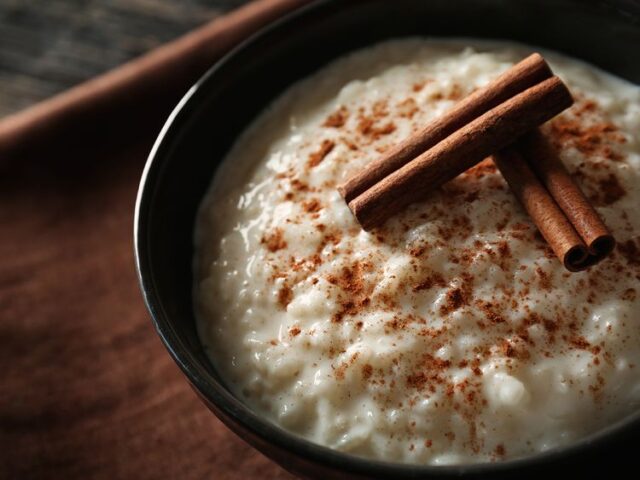
Arroz con leche, or “rice with milk,” is a beloved dessert in many parts of the world, but its history and cultural significance are not widely known. This article aims to provide a brief history of this exquisite dessert and trace its origins back to its European ancestor, rice pudding.
In this article, we will explore how arroz con leche made its way to the Americas and evolved into the unique dish that is now an integral part of Mexican cuisine. We will examine the basic ingredients and preparation methods of rice pudding, and how it evolved in European cuisine.
For those who may not be familiar with the dessert, arroz con leche is a sweet and creamy rice pudding made with milk, sugar, cinnamon, and sometimes other ingredients such as vanilla or condensed milk. The dish is typically served cold and can be garnished with fruits, nuts, or whipped cream.
Despite its humble origins, arroz con leche has become a cultural icon in many parts of the world, including Mexico, where it is a staple dessert for celebrations and family gatherings. If you are not willing to wait until the end of this article, to learn how to make this tasty sweet bite click on mahatmarice.com/recipes/arroz-con-leche/.
Join us on a journey through the history of this beloved dessert, and discover the cultural significance that has made it a beloved dish for generations.

The Origins of Rice Pudding
Rice pudding has been enjoyed in many different cultures throughout history, dating back to ancient times. It is believed to have originated in Asia, where rice was a staple food and was often used in sweet dishes as well as savory ones. Rice pudding was also popular in ancient Greece and Rome, where it was often served as a dessert or a breakfast dish.
The basic ingredients and preparation methods for rice pudding have remained relatively consistent throughout history, although there have been some variations based on regional preferences and the availability of ingredients. In general, rice pudding is made by cooking rice in milk or cream with sugar and other flavorings such as cinnamon, vanilla, or nutmeg. The mixture is simmered until the rice is cooked and the milk has thickened to a creamy consistency.
Rice pudding became especially popular in Europe during the Middle Ages, when it was often served as a remedy for ailments such as stomach problems and headaches. It was also a popular dish during religious fasting periods, as it could be made with ingredients that were allowed during these times.
In the centuries that followed, rice pudding continued to evolve in European cuisine, with variations such as Swedish risgrynsgröt and English rice pudding becoming popular. It also made its way to the Americas, where it was adapted to local ingredients and preferences. This eventually led to the creation of arroz con leche, which combined the basic ingredients of rice pudding with the addition of cinnamon and other Mexican flavors.
Despite its long history and many variations, rice pudding remains a beloved dessert in many parts of the world, and its cultural significance continues to evolve and grow.

The Journey of Arroz con Leche
This delicious dessert is believed to have made its way to the Americas through Spanish colonization in the 16th century. Spanish colonizers brought their recipes and culinary traditions with them to the New World, including the basic ingredients for rice pudding. Over time, the dish evolved to incorporate local ingredients and flavors.
As arroz con leche became more popular in Mexico, different regional variations emerged, each with its own unique ingredients and preparation methods. For example, in the Yucatan region, arroz con leche is often made with coconut milk, giving it a tropical twist. In other parts of the country, ingredients such as condensed milk or evaporated milk may be used to give the dessert a richer and creamier consistency.
This delicious sweet dish also gained popularity in other Latin American countries, where it is known by different names such as arroz con dulce in Puerto Rico and Nicaragua, and arroz con leche con coco in Colombia.
Today, arroz con leche is enjoyed by millions of people around the world, from Mexico to Spain to the Philippines. The dish remains a beloved dessert that symbolizes the rich cultural heritage and culinary traditions of Latin America.

Final Thoughts
Arroz con leche has remained a beloved dessert for centuries, and its enduring popularity can be attributed to a combination of factors. Firstly, its simplicity and versatility make it a dessert that can be enjoyed by people from all walks of life. Whether it’s served at a fancy dinner party or a family gathering, arroz con leche is a dessert that can be enjoyed by everyone.
Secondly, arroz con leche is a dessert that is deeply rooted in cultural traditions and has become an integral part of Mexican cuisine. It is a dish that has been passed down from generation to generation, with each family adding their own unique twist to the recipe. As such, arroz con leche has become a symbol of Mexican culture and heritage.
In addition, arroz con leche represents the fusion of different culinary traditions and ingredients. It is a dish that was born out of the encounter between Spanish colonizers and indigenous peoples in the Americas, and over time it has evolved to incorporate local ingredients and flavors. As such, it represents the rich cultural diversity of Latin America and the blending of different culinary traditions.
Finally, arroz con leche evokes feelings of nostalgia and comfort. For many people, it is a dessert that reminds them of home and childhood memories. It brings families together and creates a sense of community and belonging.

Conclusion
In conclusion, arroz con leche is a dessert that has stood the test of time, remaining a standout dish for centuries. Its enduring popularity can be attributed to its simplicity, versatility, cultural significance, and ability to evoke feelings of nostalgia and comfort. As a symbol of Mexican cuisine, arroz con leche reminds us of the rich cultural heritage and culinary traditions that have shaped Latin America.






